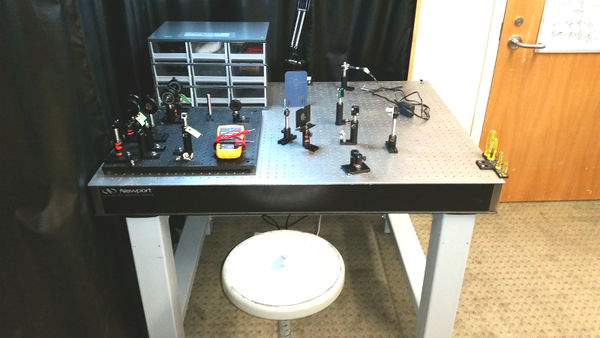Optics Obstacle Course
Permanent Materials (located on optical breadboard or in storage cabinet):
- Optics cleaning materials
- Helium Neon laser
- 4 mirrors
- Telescope lens pair (Newport KPX.097 and KPX.085)
- 3 irises and a pinhole
- Quarter waveplate @633
- Half waveplate @ 633
- Thorlabs DET110 photodetector
- Various optomechanics (mirror mounts, lens holders, baseplates, etc)
- Beam block/alignment tools
- Mystery optic
- Hecht Optics book
Materials to borrow when necessary
- Oscilloscope
- Chopper
- Power meter
- Extra optics as needed
Activities
You should have the necessary tools at your disposal to complete the following. Instructions are intentionally a bit sparse to encourage thoughtful exploration of the system. The left-hand-side of the optical breadboard is permanent storage for the optics (leave the bases and post holders where they are), and the right-hand-side contains optomechanics you can use in positioning elements in the 'sandbox' area.
- CLEAN UP THE OBSTACLE COURSE SETUP AFTER USE
Keep a journal of your activities, results and answers to any questions asked in the activities below. You will use this for your brief write-up. If any step in the activities below is unclear or you do not completely understand something ask the instructor or TAs for help before moving on.
- Read laser safety, optics common sense info (chapter 1 of the ebook "Laboratory Optics - A Practical Guide To working in an Optics Lab").
Throughout this exercise, please make an effort to never allow the laser or any reflection/retroreflection leave the boundary of the optical table - Very Important: Get a demonstration/lecture from the instructor or TAs on the proper handling and cleaning of optics. Do not proceed until this is done.
- Read about polarization in the Hecht Optics book. Use two mirrors to set the beam height to a level 4” above optical table. Is the light polarized? If not, polarize it, aligning the axis of polarization vertically.
- Use mirrors to pass beam through two irises (or two beam alignment cards), aligned along a row of holes on the table.
You now have a level beam with set polarization that is pointing in a known direction. This is an appropriately initialized optical setup. - Measure the power of the beam using two techniques: a power meter; and the Thorlabs photodetector and an oscilloscope (for this second method, you'll need to look up the responsivity curve on the detector datasheet). These two measurements should be in reasonable agreement. If they're not consult with the instructor or TAs for help. Make sure you're operating the power meter correctly. That is, use the correct power-meter detector head for your wavelength and set the power meter to your specific wavelength. Also make sure you're using an appropriate (electrical) power supply (rated at the correct voltage/current) for the power meter.
- If the photodetector appears to be saturating (detector's output voltage at spec'd maximum), you will need to use neutral density filters to reduce the power.
- For insight to what the numbers on the filters mean, measure the Optical Density (OD) of the blue laser goggles at the HeNe wavelength
- Read about half and quarter waveplates before doing the following:
- How does vertically polarized light interact with the polarizing beamsplitter cube? Use the half waveplate to rotate the axis of polarization to be horizontal. Now what happens with the cube? Finally, rotate the axis of polarization to be 45 degrees from vertical
- Align the axis of the quarter waveplate so that the beam is circularly polarized. How do you know it’s circular and not elliptical?
- Build a 1:2 telescope to expand the beam
- Draw a simple ray diagram to estimate the magnification you expect for the two supplied lenses
- Be sure to position the lenses so the beam is centered (hint: you should do this by observing the output beam location, not merely by eyeballing where the beam hits the lens)
- Ensure collimation after second lens. Does the magnification match your prediction?
- Place a pinhole at the focus of the telescope. How does this affect the properties of the beam? Why does this happen?
- Focus light onto a small photodiode. Use a chopper and oscilloscope to measure the rise time of the diode. How does this rise time compare to a photodiode of larger area? Can you explain? Note: When using the chopper, use a converging lens to focus the beam (to a small spot) in the plane of the chopper and another lens to re-collimate the beam after the chopper. If this doesn't make sense ask the TA or instructor to explain.
- Identify the mystery optic.
- Debrief with the instructor concerning your efforts, observations and measurements of the obstacle course.
- Submit a write-up outlining your activities, results and the answers to all the questions asked above.
After you finish, please return items to the storage location and clear the 'sandbox' area.
- CLEAN UP THE OBSTACLE COURSE SETUP AFTER USE
Notes:
- Considering the Fresnel relations on the reflection of light off a strongly absorbing medium - linearly polarized light is usually elliptically polarized after reflection off a metallic mirror except for the cases where the incoming polarization is parallel or perpendicular to the plane of incidence.

